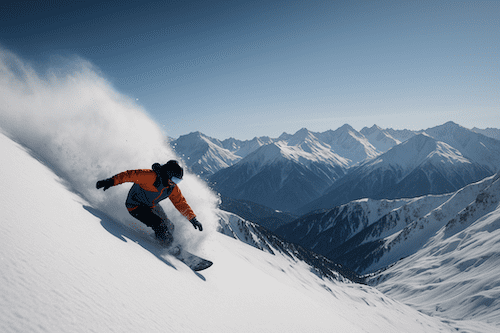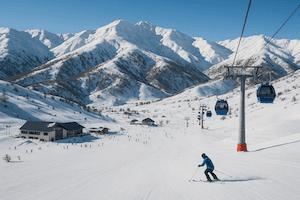
Amirsoy Expansion Project Uzbekistan
Uzbekistan is Planning to Create a 100 KM Slope Ski Resort by Connecting Multiple Resorts under the Amirsoy Expansion Project
Introduction: A Vision for a 100-Kilometer Mega Ski Resort
Uzbekistan is preparing to make a bold statement in the world of winter tourism. The Amirsoy Expansion Project is set to transform the country’s flagship ski destination into a mega resort of around 100 kilometers of slopes, connecting Amirsoy with the historic ski areas of Chimgan and Beldersay.
If these plans come to life, Central Asia will have a world-class ski domain to rival many European resorts, offering everything from challenging off-piste adventures to family-friendly beginner runs.

Where Will the Amirsoy Expansion Project be Build?
Amirsoy Expansion Project Map
The Amirsoy Expansion Project will be created by connecting Amirsoy, Chimgan and Beldersay with ski lifts.
Connected Resorts
- Amirsoy
- Chimgan
- Beldersay
Watch our Video about the Amirsoy expansion Project
👉See all the details about this Amirsoy Expansion video
Amirsoy’s Next Stage of Growth
Since opening in 2019, Amirsoy Mountain Resort has quickly established itself as Uzbekistan’s premier ski destination, offering around 15 kilometers of well-groomed runs, modern lifts, and luxury chalets. Visitor demand has grown far beyond initial expectations, prompting an ambitious new phase of development. The expansion will introduce multiple new slopes across various difficulty levels, a 16.8-kilometer signature ski trail in the western zone, and a dedicated freeride area for advanced skiers. Additional lifts, including new gondolas and chairlifts, will boost uphill capacity and reduce waiting times.
The resort is also broadening its appeal beyond skiing. Plans include a year-round water park, a 2-kilometer zipline, and a cluster of new restaurants capable of seating over 2,400 guests. A multi-level parking facility for 500 vehicles will help accommodate the rising number of visitors, and two new hotels – one 4-star and one 5-star – will add 350 beds to meet the growing demand for on-site accommodation.
Linking to Beldersay: A Regional Game-Changer
A defining feature of the expansion is the planned lift connection between Amirsoy and the neighboring Beldersay ski area. Once completed, this will allow skiers to move seamlessly between the two resorts without needing road transfers, instantly increasing accessible terrain. While the exact route of the connection is still being finalised, Amirsoy’s management has made clear that this link is a priority, aiming for completion within the next five years. When combined with the ongoing redevelopment of Chimgan and Beldersay, this will create an interconnected ski region unmatched in Central Asia.
Chimgan and Beldersay’s Transformation
The Amirsoy expansion coincides with a major government-backed redevelopment of Chimgan and Beldersay. Supported by French investment and international ski infrastructure specialists, the project includes six new lifts, such as a 10-person gondola and an 80-person aerial tram reaching the 3,309-meter summit of Mount Chimgan.
The initial phase will deliver more than 20 kilometers of marked trails, with long-term plans to expand to around 60 kilometers. New hotels, cottages, and a wide range of year-round attractions – from alpine coasters to mountain biking trails – will complete the transformation. The first phase is targeted for opening in the 2025/26 winter season, and construction is already in progress.
Beyond the Flagship Project: Other Ski Developments
While the Amirsoy–Chimgan–Beldersay region is the centerpiece of Uzbekistan’s winter tourism strategy, other ski projects are also taking shape. In the Jizzakh region, Zaamin Ski Resort has recently opened with an 8-person gondola reaching alpine terrain at 2,500 meters. Though smaller in scale, it offers pristine slopes and has the potential for future expansion. Meanwhile, the Charvak Lakeside “Sea Breeze Uzbekistan” project is set to become a major year-round tourism hub, providing a high-end base for visitors exploring both the lake and the surrounding mountains.
Economic Impact and Investment Confidence
The Amirsoy Expansion Project is supported by €30–40 million in new funding, adding to the €130 million already invested in the resort’s initial development. The primary investor, Swiss-based Pro Alpina, holds a majority stake, with strong backing from the Uzbek government. The anticipated benefits are substantial: an increase in international visitors, a longer tourism season, hundreds of permanent jobs, and a significant boost to the regional economy. By positioning itself as a new hub for winter sports in Central Asia, Uzbekistan is diversifying its tourism portfolio and opening fresh opportunities for both local businesses and foreign investors.
A Timeline to Watch
Key milestones are already on the horizon. The two new hotels at Amirsoy are expected to open for the 2024/25 winter season. Chimgan and Beldersay’s new lifts and slopes are targeting a debut in 2025/26. The Amirsoy–Beldersay connection is planned for completion by 2028, at which point the vision of a fully integrated 100-kilometer mega resort could become a reality.
Conclusion: Central Asia’s New Alpine Destination
The Amirsoy Expansion Project represents more than just an upgrade to an existing resort – it is a step toward creating a new winter sports powerhouse in Central Asia. With modern lifts, diverse slopes, luxury accommodation, and year-round attractions, this interconnected resort network has the potential to draw skiers and snowboarders from around the world.
If the plans stay on track, Uzbekistan could soon find itself mentioned in the same breath as established Alpine and Rockies destinations, offering something entirely unique: the spirit of the mountains, reimagined for a new generation of travelers.
